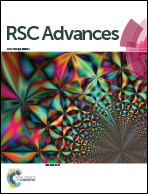Palladium nanoparticles supported on agarose-functionalized magnetic nanoparticles of Fe3O4 as a recyclable catalyst for C–C bond formation via Suzuki–Miyaura, Heck–Mizoroki and Sonogashira–Hagihara coupling reactions†
Abstract
In this paper, the preparation of palladium nanoparticles supported on agarose-functionalized magnetic nanoparticles of Fe3O4 is described. The new material was characterized by EDX, TEM, TGA, FT-IR, VSM, AAS, and solid UV-visible analysis. This magnetic material has been successfully applied as a highly efficient, magnetically recoverable and air-stable catalyst for the Suzuki–Miyaura, Heck–Mizoroki and Sonogashira–Hagihara coupling reactions. Using this material as a catalyst, a wide range of substrates was employed for carbon–carbon bond formation in wet PEG 200.


 Please wait while we load your content...
Please wait while we load your content...